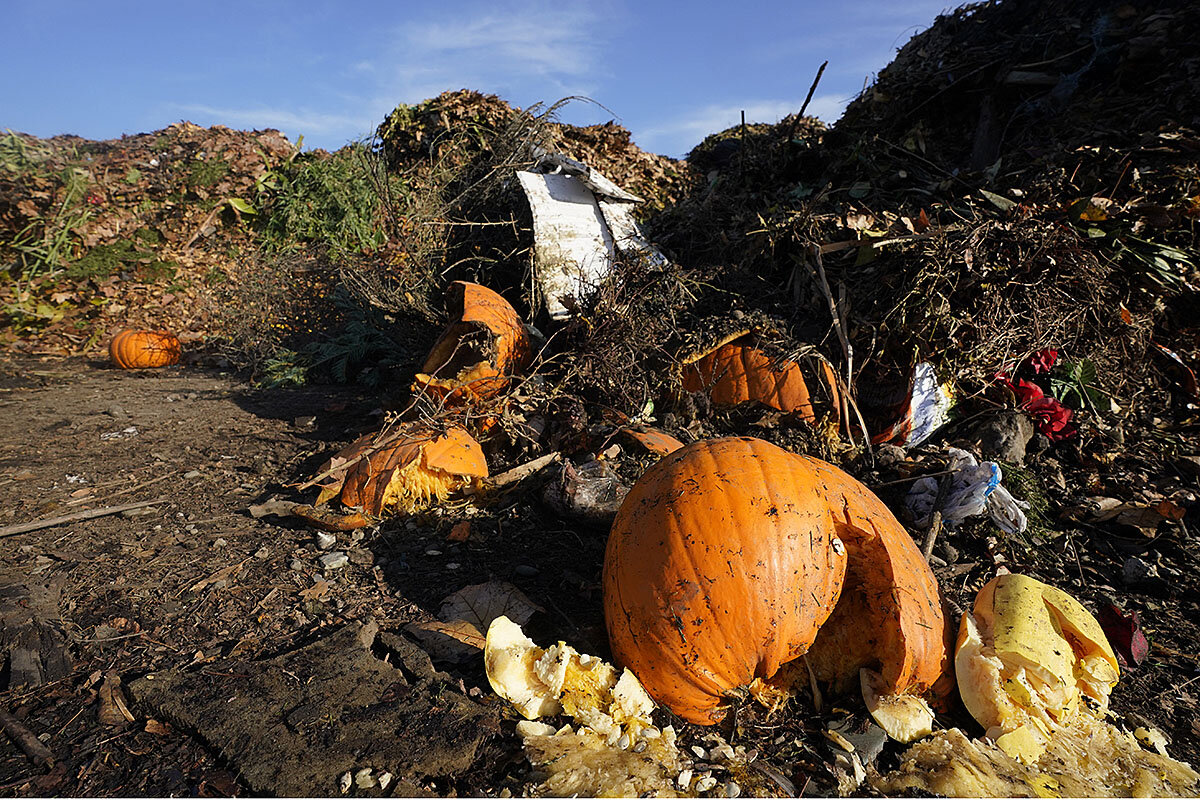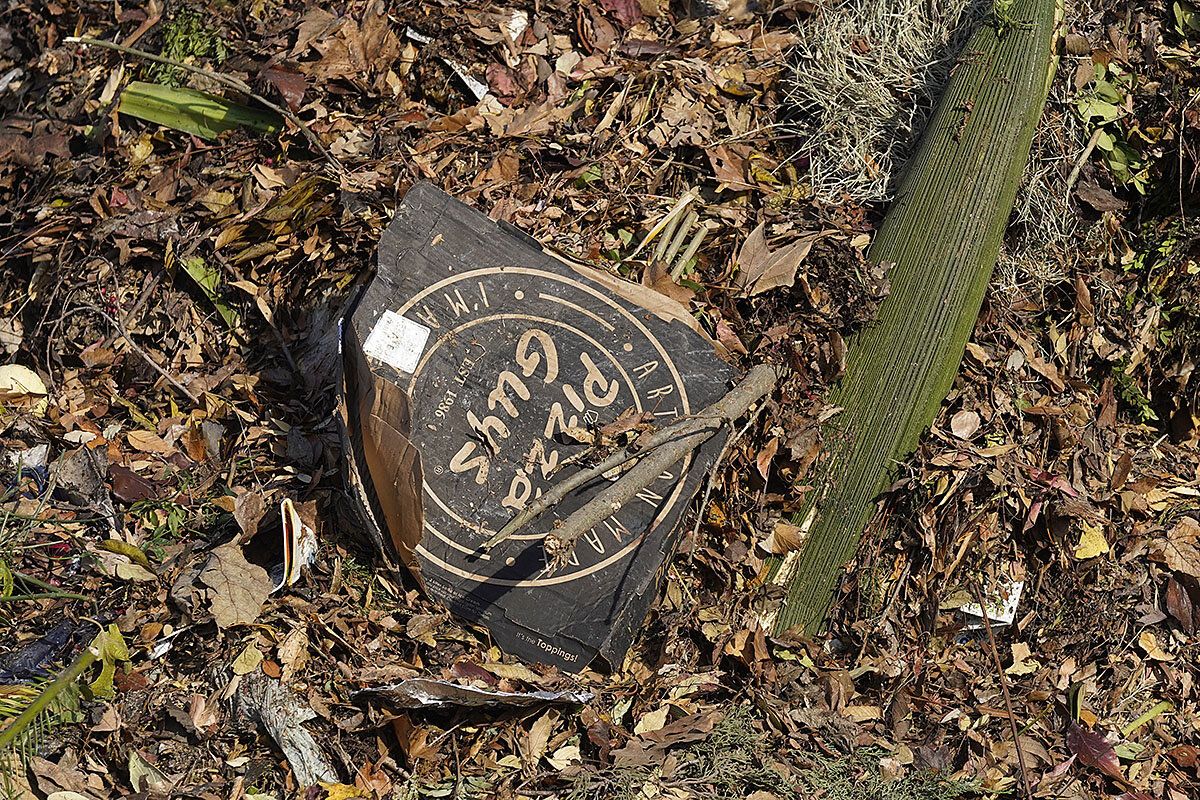Don’t pitch those peels, recycle them: California’s new food-waste law
Loading...
| Pasadena, Calif.
Recycling kitchen scraps and unused food is the single easiest and fastest thing that every person can do to fight climate change, according to California recycling officials. That’s why, beginning Jan. 1, the most populous state in the nation is requiring every city and county to have a program to collect organic waste – from eggshells to yard trimmings – and turn it into compost, biofuel, or energy.
Several states, and even a few countries, such as France, have some type of law to keep food waste out of landfills, where it rots and gives off methane. That “super pollutant” greenhouse gas is 84 times more powerful and has a much worse short-term impact on the atmosphere than carbon dioxide. Yet, only tiny Vermont – with a population of about 625,000 – and mammoth California – with nearly 40 million people — have laws requiring universal recycling of organic waste by residents and businesses.
Given California’s size, the law’s potential for greenhouse gas reduction in the state is “huge,” says Rebecca Ryals, an assistant professor at the University of California, Merced, who is also a soil and climate-change expert. Organics make up more than half of everything Californians throw into landfills, which, themselves, account for 20% of the state’s methane pollution, according to CalRecycle, the state department of recycling.
Why We Wrote This
Can one person help keep super pollutants out of the atmosphere? Yes, says California. And soon it’ll be illegal not to.
Getting organics out of landfills and reprocessing them “is an excellent goal; it’s a challenging goal,” says Professor Ryals. Below, the Monitor looks at what the law requires, how it can affect climate change, and the challenges of implementing the law.
What does California’s organic-waste law require?
Passed in 2016, the law (SB 1383) sets the state on a course to drastically reduce short-term super pollutants like methane, including a goal to reduce organic waste disposal by 75% by 2025. Starting next month, cities and counties must have programs to divert green waste from landfills by collecting it, and then either composting it or turning it into biofuel or energy. And they must procure and then utilize themselves or give away some of the compost, biofuel, or energy – by using biofuel in their government vehicles or spreading compost on public lands, for instance.
Residents can compost their own organic waste, but most people and businesses will rely on local waste management services to do the recycling for them. The main work for most homeowners and apartment dwellers will be to separate their kitchen scraps – bones and unused meat, sauces, vegetables, tea bags, coffee grinds and filters, banana peels, etc. – into a pail, and then empty that into yard-waste recycling bins.
Another goal of the law is to divert 20% of unused, edible food to people who need it. Starting in January, supermarkets must donate excess food to food banks instead of sending it to landfills. The same will hold true for hospitals, restaurants, schools, and other big food users in 2024.
The law has teeth, putting the burden of enforcement on cities and counties, with stiff fines if they don’t comply. Right now, though, CalRecycle says it’s more interested in educating about the law, which is the biggest change to trash since the state started recycling in the 1980s.
How does recycling food and yard waste help with climate change?
Climate scientists say the fastest way to bend the global-warming curve is to cut back on very potent greenhouse gases like methane.
Composting gives off minimal methane compared with landfills – 22 times less, says Neil Edgar, executive director of California Compost Coalition, a lobbying group for organic-material recyclers and composters. The process produces carbon dioxide (less potent and less damaging in the short term than methane), and has many benefits, says Mr. Edgar. Compost replenishes soil, which fosters plant growth – which, in turn, takes CO2 out of the air. And it keeps moisture in the soil, so there is less need for energy to pump water. In a heavily agricultural state like California, those are big pluses.
The other way to recycle organic waste is to use anaerobic digesters, which are more familiarly known for their ability to break down sewage sludge. Sending food and yard waste through this process produces methane that then gets turned either into biofuel or electricity.
Landfills, too, can capture methane for energy, “but it’s not super efficient,” and there are a lot of “fugitive emissions” that escape, says Professor Ryals. “Sending organics to landfills just makes no sense.”
One problem with sending food and yard waste to composting and anaerobic digesting centers is the long distances that diesel trucks sometimes have to travel to transport the waste from homes and businesses. That’s an argument for more locally based recycling centers and trucks that burn clean fuel, say experts.
How hard will it be to implement this law?
Here’s where Vermont’s experience is instructive. It passed universal organics recycling in 2012, but just implemented the final phase – residences – in 2020. Josh Kelly, supervisor of materials management for Vermont’s Department of Environmental Conservation, calls organics recycling “a major change” in people’s habits. It won’t take hold overnight. “It’s like the seatbelt law,” he says. “We know people don’t all do it.”
On the plus side, Vermont’s organics-recycling law nearly tripled food donations in the early years, and composting and anaerobic digester centers have mostly seen year-over-year increases. The number of food scrap haulers has almost quadrupled. The law aimed to build a green infrastructure and jobs, and so far, it’s doing that, Mr. Kelly says.
On the other hand, trash haulers were reluctant to comply, and the requirement to offer organic waste collection services was delayed and modified. Now there’s concern about how to handle packaged food, because of plastics and metals.
In California, the southern part of the state lags, compared with the north. San Francisco, for instance, has required businesses and residents to put food scraps in curbside green bins since 2009. By contrast, neither Los Angeles nor San Diego is fully ready, and the state will need more composting and anaerobic digesting centers.
Pasadena, which is part of Los Angeles County, has been preparing for two years. It will use existing infrastructure and try to keep things local.
Residents are to bag their kitchen waste and add it to their yard-waste bin. Food waste will be manually separated from yard waste at the local landfill, and turned into liquified bioslurry. That slurry will be fed into an existing anaerobic digesting facility at a Los Angeles County wastewater treatment plant. The resulting renewable natural gas powers the wastewater facility and Pasadena city vehicles, which run on natural gas. It’s a “win-win,” says Thanos Gauthier, the administrator of resource, recovery, and recycling in Pasadena.
Mr. Gauthier says his biggest takeaway from studying other places is that residents will resist separating out food waste because of the “ick factor” – the smell, the mess, the potential for vermin. That’s why the city says residents should put their kitchen food scraps into plastic bags – repurposing bags they have on hand, like produce bags – and also continue to use garbage disposals as they normally would. “We are trying to make things simple,” he adds.
But making sure businesses and larger multi-unit residential buildings are complying is much harder, because they are serviced by private haulers, not the city. The haulers will have to work out arrangements with their customers, yet the city will have to ensure compliance, and that will require more resources.
Also, there is no place close to Pasadena to handle the yard waste. For two years, it’s been sent for composting to Oxnard, about 75 miles away. Trash collection fees, which haven’t been raised in a decade, are going to have to increase, says Mr. Gauthier.
“Our local municipalities need more resources to get this off the ground,” says Professor Ryals. “What we don’t want is for the implementation to be hurried, not done well, or poor communication, and all the stuff ends up in the landfill anyway.”








